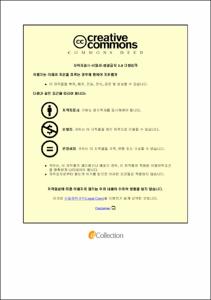Enhanced biomass and lipid productions from various marine microalgae using light-emitting diodes (LEDs) and two-phase culture system
- Alternative Title
- LED광원과 배양시스템을 이용한 해양미세조류 바이오매스와 지질생산 향상에 대한 연구
- Abstract
- 3세대 바이오매스인 미세조류는 빠른 성장, 높은 바이오매스 생산량, 높은 지질 함량, 경작지에 대한이점을 가지고 있다. 이 연구는 LED광원과 배양시스템을 이용하여 여러가지 미세조류의 바이오매스, 지질, 지방산 생산을 향상하였다. 1장은 Phaeodatylum tricornutum, Dunaliella teritolect, and Isocrhysis galbana 를 F/2배지를 이용하여 청색 LED파장 (465 nm)와 형광등을 12:12 LD cycle로 20℃에서 100μmol/m2/s의 광량을 사용하며, 2.5L/m의 공기를 공급하여 배양하였다. 또한 질소원 (8,12,16,20,24mg/L)을 각각 2L 배양하여 최적 질소원 농도를 확립하였다. 최적 질소원 농도에 따른 20 mg/L의 질소원 배지에서 P. tricornutum는 1.35g/L의 성장을 보였으며, D. teritolect는 12 mg/L에서 0.63 g/L의 성장하였고, I. galbana는 16 mg/L에서 1.47 g/L의 성장을 보였다. 지질의 향상을 위하여 배지 내 질소원을 제거하는 방법과 0.5 M의 NaCl을 첨가하는 방법, LED 녹색광원 (520 nm)으로 광원을 교체하는 방법을 이용하여 3일간 실험하였다. 이러한 2단계 배양 방법에서 미세조류는 높은 바이오매스 생산량, 높은 지질축적 과 높은 불포화지방산의 분포를 나타내었다. 가장 높은 효과를 보인 배양 방법은 LED 녹색광원를 이용한 것이며, 2일차에 각각의 미세조류에서 기존 1단계 배양 보다 51, 64, 70%의 지질 향상을 보였으며, 불포화 지방산 분포 또한 다른 배양 방법보다 높은 것을 확인 할 수 있었다. 2장은 Phaeodactylum tricornutum, Isochrysis galbana, Nannochloropsis salina, N. oceanica 그리고 Picochlorum atomus를 이용하여 적색과 청색을 혼합한 LED광원을 이용하여 배양을 하여 바이오매스와 지질 함량을 증가시키는 연구이다. 또한 적색과 청색을 혼합한 LED광원을 이용하여 배양한 미세조류는 형광등을 이용한 배양에서 보다 높은 색소 (chlorophyll a and b, and carotenoids)함량을 나타내었다. 배양 이후 3일간의 질소원 저해를 받은 미세조류내 최고 지질생산량은 P. tricornutum에서 47.3 mg/L/day, I. galbana에서 47.8 mg/L/day, N. salina에서 45.7 mg/L/day, N. oceanica에서 29.3 mg/L/day 그리고 P. atomus에서 34.3 mg/L/day을 보였다. 이 연구에서 P. tricornutum와 I. galbana가 가장 높은 지질생산량을 보였다. 이러한 적색과 청색을 혼합한 LED광원을 이용한 배양 방법은 형광등 보다 바이오매스 생산에서 31.0%, 지질생산에선 41.7%의 소비전력에 따른 생산량이 높은 것을 확인 할 수 있었다. 이러한 배양방법으로 배양한 5종의 미세조류에서 최고 지방산 분포는 palmitic acid (C16:0)였으며, 함량은 총 지방산 함량에 33.8%–56.0% (w/w)를 차지하였다. 이러한 2가지 연구를 통하여서 LED광원을 이용한 미세조류의 배양 방법의 이점과 그에 따른 생산량 증가를 확인 한 결과를 얻었다.
- Issued Date
- 2017
- Awarded Date
- 2017. 2
- Type
- Dissertation
- Keyword
- microalgae lipid LED fatty acid
- Publisher
- 부경대학교 대학원
- Affiliation
- 부경대학교 대학원
- Department
- 대학원 생물공학과
- Advisor
- 김성구
- Table Of Contents
- Chapter Ⅰ Enhanced unsaturated fatty acid production from various marine microalgae using light-emitting diodes (LEDs) and two-phase culture system 5
1.1. Introduction 5
1.2. Materials and Methods 6
1.2.1. Microalgae strains and culture conditions 6
1.2.2. Light source for microalgae culture 6
1.2.3. Two-stage and two-phase culture system 9
1.2.4. Lipid extraction and transesterification 9
1.2.5. Analyses 10
1.3. Results and Discussion 10
1.3.1. Effect of growth rate on LED blue wavelength 10
1.3.2. Optimal nitrate content on LED blue wavelength 13
1.3.3. Microalgae culture using two-stage and two-phase culture systems 15
1.3.4. Fatty acid composition using two-stage and two-phase culture systems 19
1.4. Conclusions 21
1.5. References 21
Chapter Ⅱ Effects of light-emitting diodes (LEDs) with a mixture of wavelengths on the growth and lipid content of five microalgae 24
2.1. Introduction 24
2.2. Materials and Methods 25
2.2.1. Microalgal strains and culture conditions 25
2.2.2. Light source for microalgae culture 26
2.2.3. Lipid extraction and transesterification 28
2.2.4. Analyses 28
2.2.5. Statistical analysis 29
2.3. Results and Discussion 30
2.3.1. Effects of LED light with a mixture of wavelengths on the growth of microalgae 30
2.3.2. Effects of LED light with a mixture of wavelengths on Chl a, Chl b, and carotenoids 33
2.3.3. Lipid productivity and consumption of light energy 35
2.3.4. Fatty acid composition 37
2.4. Conclusions 39
2.5. References 39
- Degree
- Master
- Files in This Item:
-
-
Download
 Enhanced biomass and lipid productions from various marine microalgae using light-emitting diodes (L.pdf
기타 데이터 / 1.5 MB / Adobe PDF
Enhanced biomass and lipid productions from various marine microalgae using light-emitting diodes (L.pdf
기타 데이터 / 1.5 MB / Adobe PDF
-
Items in Repository are protected by copyright, with all rights reserved, unless otherwise indicated.